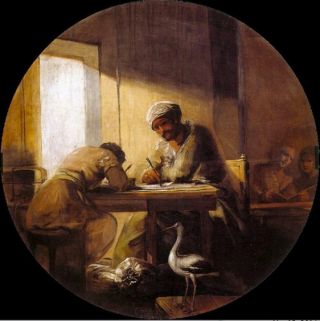Prisoner's Dilemma
The How of High
When ordinary people do better than expected
Posted March 31, 2014
[Written with Yuanbo Wang]
It’s a win-win-win

It’s a win-win-win
You can’t get the-ah from he-ah. ~ New England saying
Thursday is hunting day. On Wednesday, Crusoe and Friday are at the East and the West end of the island, respectively. They can both go to the North end where goats are plentiful, or they can go the South end to chase rabbits. Either way, they need to hunt together to succeed. They both go to the North end and have a rich supper that night.
Game theory derives rational strategies in interdependent situations. When real people act differently, some theorists infer that these people are irrational, while other theorists don’t even care. They don’t care because they don’t consider human behavior to be the object of the theory. This is hardly a respectable position. Game theorists should care because derivation for derivation’s sake – what is it good for? Psychologists do care inasmuch as they understand game theory, and some try fix this theory to close the discrepancies between theory and behavior or they propose new theories with more explanatory power. There are many interpersonal games, in which people do surprisingly well. The prisoner’s dilemma dominates the psychological and economical literature, followed by the games of chicken, stag hung (assurance), volunteering, trust, or ultimatum.

Some games receive attention because of their apparent simplicity. Yet, they may provide a window into some of the most vexing theoretical issues. Andrew Colman (2003) pointed out that the High-Low coordination game (hereafter: Hi-Lo) is such a case. The matrix shows that row player P1 (Crusoe) and column player P2 (Friday) each have a choice between strategy H (North end) and strategy L (South end). If both choose H, they receive payoff R (goats), if both choose L, they both receive payoff P (rabbits), otherwise nothing. When R > P, the intuition to choose H is overwhelming, and that is what most people do.
Meeting challenges of interpersonal coordination is a fundamental task for any social animal, and in the Hi-Lo game, it seems trivially easy. The story would end here if game or psychological theory could explain the appeal of strategy H, but they cannot (we’ll note an exception later). Game theory notes that there are two pure Nash equilibria: HH and LL. When both players make the same choice, neither has an incentive (other than spite) to switch strategy. These pure equilibria can only be recognized after they fact, but they cannot guide choice. To guide choice, game theory points to a third equilibrium, which comprises a probabilistic strategy mix. A rational player chooses H with probability α = P/(R+P). If R = 2 and P = 1, α = 1/3. Ouch! How can this probability be rational if it is so shockingly low? When R increases relative to P, the intuitive pull of H increases rises, whereas the rational probability α of playing H falls. Hard-shell game theorists don’t see anything wrong with that. They point to the logic of the mixed-strategy Nash equilibrium: Playing H with probability α, P2 equalizes the expected values of H and L for P1. If R = 2 and P = 1, P1 expects a payoff of 2/3 both from choosing H (1/3 x 2) and from choosing L (2/3 x 1). Since the game is symmetrical, P1 (so game theory) chooses H with probability α so that P2 is also indifferent. The result of the mixed-strategy equilibrium strategy is that no player can be ambushed by a spiteful opponent who responds to H with L and to L with H. The equilibrium strategy guarantees the expected value of R/(R+P). The equilibrium strategy is a way of playing it safe. It provides a minimum payoff greater than the payoff of dis-coordination. This is a hollow victory when P is a grain of rice and R is a house in Malibu. How, then, can the mixed strategy be rational for any set of payoffs?
Andrew Colman (2003) used Hi-Lo to drive a dagger into the heart of social preference theories. Social preference theories suggest that many people care about the payoffs of others and that they dislike inequality. Such people are called prosocials, and they seem nice. However, an aversion to inequality is moot in Hi-Lo because it cannot tell the difference between HH and LL. Caring for others is of no help either. Suppose P1 is as happy about P2’s payoff as she is about her own. She ‘transforms the given matrix into an effective matrix’ (as interdependence theorists put it) by adding P2’s payoff to her own. Now R = 4 and P = 2. Yet, α is still 1/3, and the decision-maker is no closer to making a decision. Social preference theory has to sheepishly concede that it does not apply to this coordination game. This would not be tragic were it not for the existence of many games that stump this theory (see Krueger, Massey, & DiDonato, 2008). Social preference theory is, after all, a theory of preference, and not a theory of strategic behavior.
Social projection theory (Krueger, 2014) offers a solution. I choose H because I regard my own choice as diagnostic (not causal) of the other player’s choice. I choose H because that’s what a rational person does, and I assume that the other person sees it this way too. Fear of being ambushed by a spiteful player who wants me to get nothing is irrelevant because this other player has no reason to believe that I will choose H. How does she know that I am not spiteful too? To ambush me, she would have to be both spiteful and clairvoyant. Two spiteful players playing against each other cannot improve over the equilibrium strategy. If I, a spiteless person, think I might be paired with one of them, I can still choose H and assume that my expected value is at least 1/3.
In Hi-Lo and in many other games (e.g., prisoner, chicken, stag), social projection nudges us toward a win-win outcome. All we have to do is egocentrically – yet rationally – assume that most of us will converge on a majority choice. This is, of course, a wonderfully tautological idea. It is true nevertheless and because of that. There is no need to call upon social influence, social preferences, of even interpersonal trust. The ‘no need’ argument is easily misunderstood as a rejection of these concepts. This misunderstanding comes from the fear that our world would be horrible without social influence, preferences, and trust. Fear narrows perception. Let us open our eyes and see that influence, preferences, and trust pervade our lives; yet, sometimes we can do well by ourselves and others even without them.
Goya on win-win

Goya on win-win
Francisco Goya, Spain's great transitional painter, depicted his vision of trust and mutual prosperity in his painting "El Comercio." Business - as many types of human exchange - have the potential of being a win-win arrangement. Let game theory not throw us off course.
Colman, A. M. (2003). Cooperation, psychological game theory, and limitations of rationality in social interaction. Behavioral and Brain Sciences, 26, 139–198.
Krueger, J. I. (2013). Social projection as a source of cooperation. Current Directions in Psychological Science, 22, 289-294.
Krueger, J. I., Massey, A. L., & DiDonato, T. E. (2008). A matter of trust: From social preferences to the strategic adherence to social norms. Negotiation & Conflict Management Research, 1, 31-52.


